
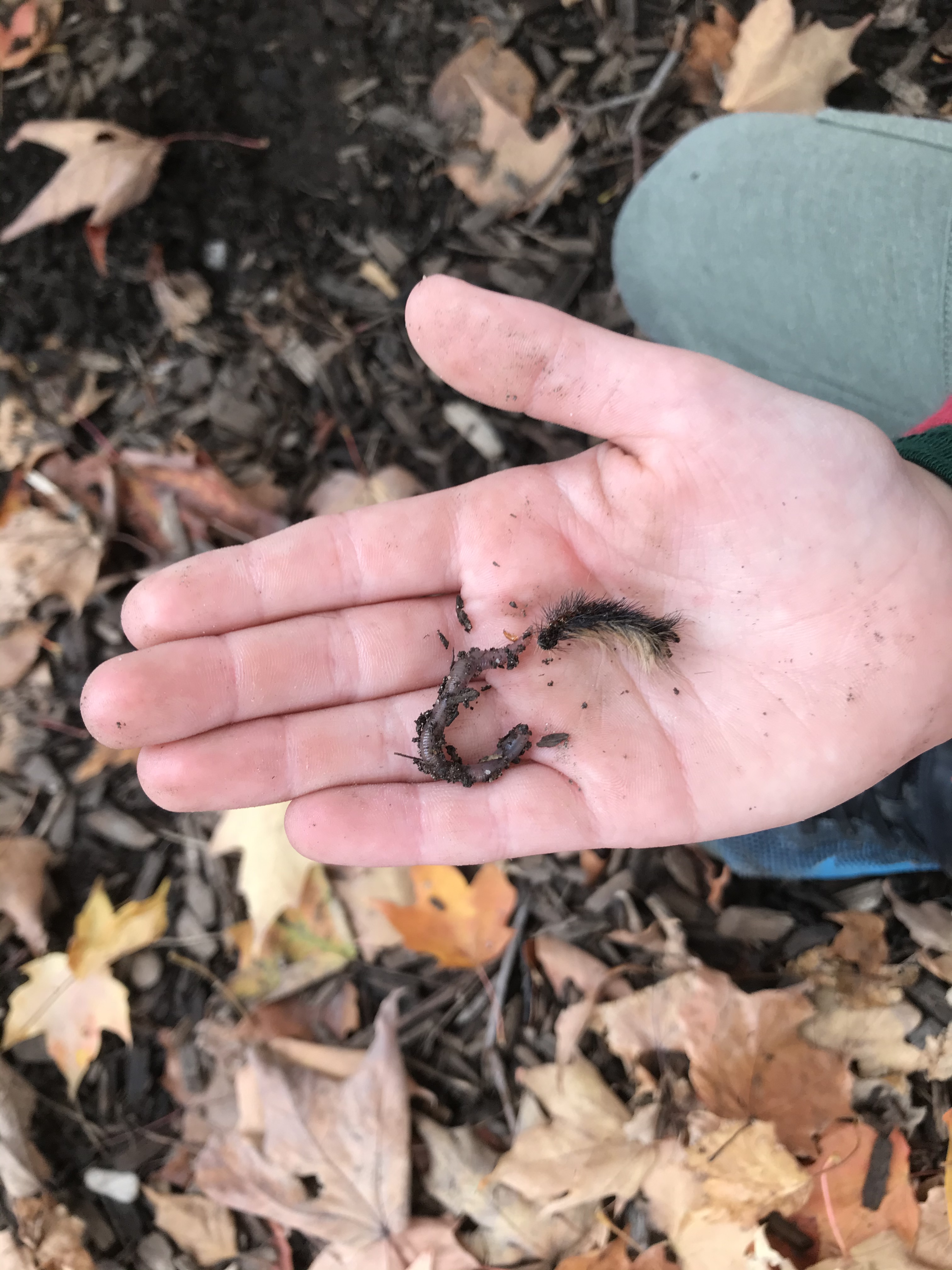
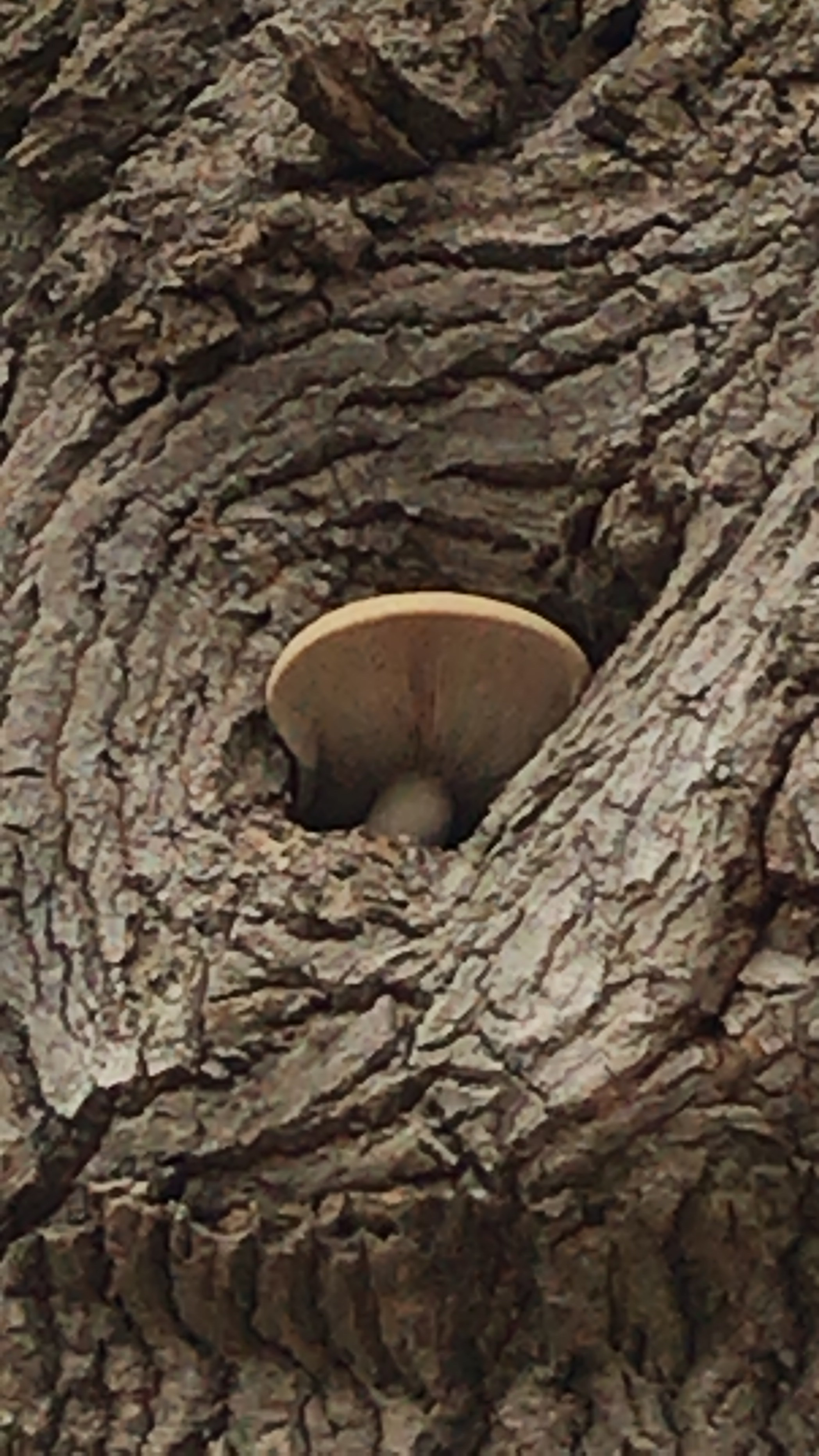
Here we are, the beginning of a New Year, and in the middle of a break from what Covid-19 has meant in the classroom for the last four months. In our region, we aren’t heading back to the classroom just yet, as we are in lockdown. However, I am hopeful that we will be returning soon, and so I want to share how I navigated the fall as an Elementary School Teacher and what I’ve learned from engaging students in learning in the land during this pandemic.
To begin with, it wasn’t an easy decision to take students outside despite all of the proven health benefits for myself and my students derived from learning in the land. Even knowing that we are safer outdoors during Covid-19, it still felt like a hard call to make, due mainly to the fact that the parameters for indoor learning were more clearly laid out than those for the outdoors. Indoors, we were given clear guidelines for classroom layout (desks needed to be at least 1 m. apart), and there was visible arrows and signage to support controlled movement in the halls. There were many times when I considered that the safest option might be to simply keep the students at their desks, and I contemplated shifting my practice indoors. But then, thankfully, I had a louder voice in my heart and in my head that reminded me that we all need the land, and the land needs us. And so, I put my heart and my head into figuring out how I could confidently bring students outside.
I started by considering how to gather a group outside. In my practice, I have embedded the Indigenous practice of gathering in a circle. I have learned this practice from many professional learning opportunities offered through my board with local Indigenous community members and leaders. Over the years I have found that it can be a little challenging to gather our youngest learners in a circle, and last year I took inspiration from Juliet Robertson’s use of ropes outdoors. I developed the strategy of using a long rope, otherwise known to my students as “Suzanne the Snake”, to gather us with ease. This year, I adapted this idea by adding stripes at 1m markings to the rope, thus creating Suzanne’s cousin, “Samuel the Snake”. Samuel fits nicely in my backpack, and has been a very helpful resource!
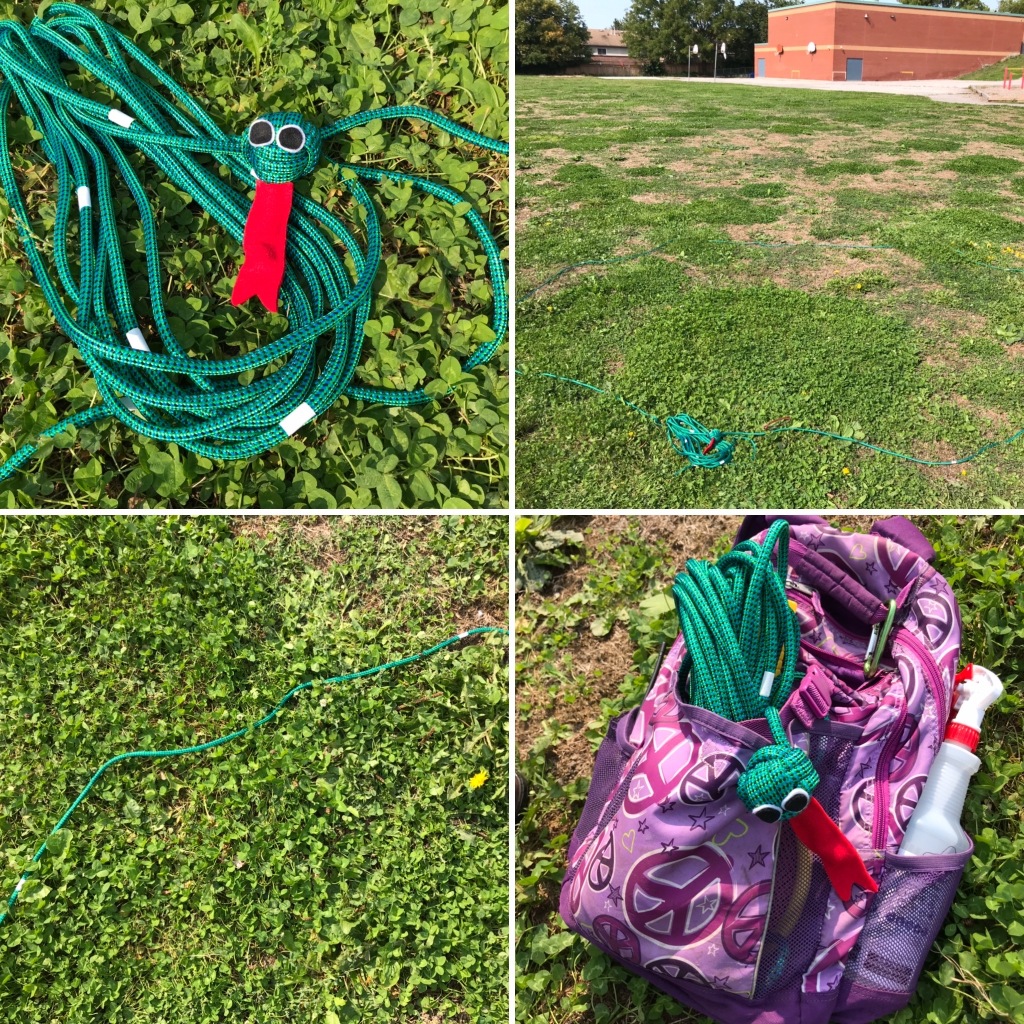
I introduced Samuel to the students by name. I let them know how much he likes to hear children’s voices and giggles, and how much he loves to hear their ideas. I told them he is kind and gentle, and not poisonous at all. In the time of Covid-19, where we don’t want children touching shared objects, I also explained that though he isn’t poisonous to us, we are poisonous to him, and if we touch him, he will get sick and I will have to take him to the doctor. I explain that I have taken a Snake Training Course, and been given a special ointment that ensures I can touch him and he won’t get sick. So far, this has helped ensure that children aren’t touching him. And it has also been a very useful tool to help me feel confident that we are all keeping our distance from each other while we gather. You’ll see here a reference sheet I created for anyone wanting to make their own gathering snake. You can get a printable copy HERE.
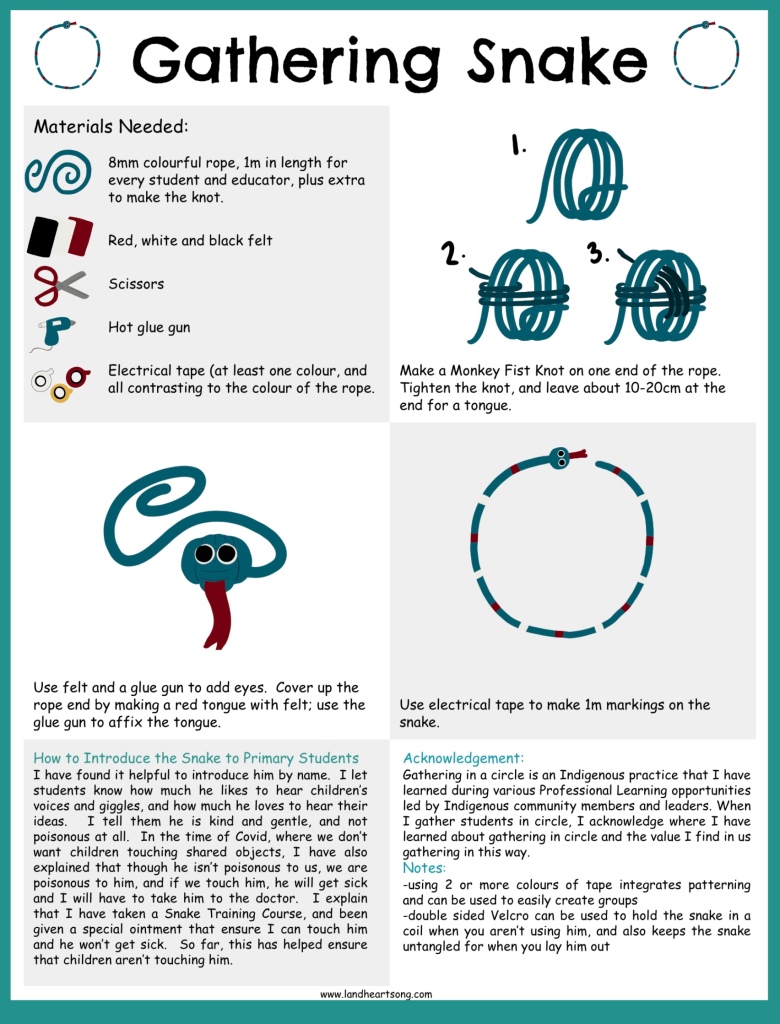
The next challenge was what to do with my routine of a Wonder Walk (our “marche de merveille”). In the past, I have a routine of bringing students to our learning space, and giving them time to explore and make observations about what is happening in the land before we gather in circle. However, human nature is to share discoveries with each other, and so when students find little friends in the dirt, or the nest in the Maple tree, it is natural for children to gather close together in excitement and wonder. As a teacher, these moments are gold and great launching points for inquiry, as well as a great opportunity to build a love of learning and of the land. But during Covid-19, these moments became very concerning from a health and safety lens. So I was feeling quite torn about how to continue this practice safely.
Then I heard Dr. Brian Goldman on the CBC Radio talk about his castle metaphor, which I took and ran with. I’ve written a whole blog post about it HERE, where you can also find downloadable posters in French and English for you to print off for your school, should you choose to try out this strategy. Using Dr. Goldman’s metaphor, I taught students that they are a prince or a princess in a castle, and when they play, it is their high walls (their masks) and their moats (safe distance) that will keep them safe. This strategy helped a lot in helping me feel confident in getting students to move around outside safely.
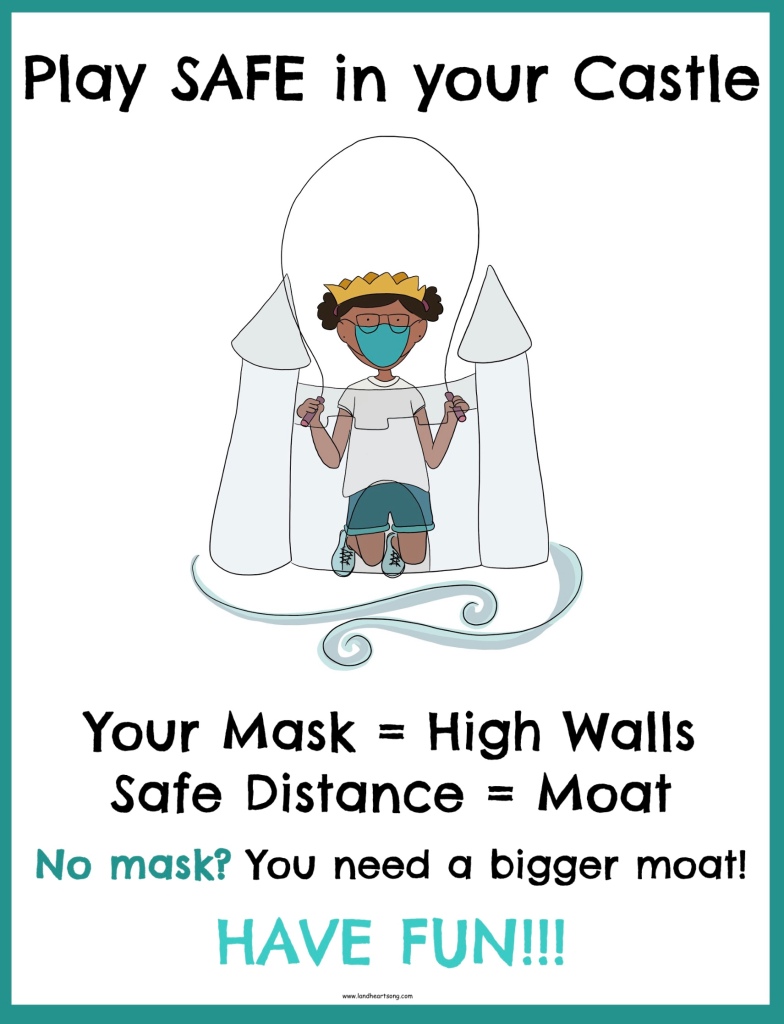
At the point of developing these two strategies, I finally had the confidence to take students outside consistently. However, the learning at my end was far from over. I noticed how desperate students were to simply dig in the dirt and to engage in movement. It was evident that my students had a very tactile and physical need to connect with the land. It took me quite a while to find ways to make space for these needs, while also addressing the Music curriculum. At many points in time, I struggled. Sometimes, it felt like I could simply address the curriculum more easily in the classroom. But again, a louder voice in my heart and in my head reminded me that we all need the land, and the land needs us. And so we continued on, learning together about how to meet student needs and uncover curriculum in the land.

Enter this little friend, Red the Fox, who has become my best friend when working in the land with young children. He allows me to be funny with students, without the funniness directly coming from me, and he inspires students in a way that I can’t do on my own. He has spent most of the fall with us, teaching students how to dance to the beat of a French song about puppets, and being there to encourage students when they try something new. And now, he is a great help in getting us exploring in a safe way. Our “Wonder Walk” has become our “Fox Walk”, and Red and I invite students to turn into foxes as they enter our learning space. Students are learning to walk slowly and quietly, keeping an eye out for predators and for safe places to find shelter. They look for water and for food, and they look for changes in the land. As they do their Fox Walk, I lay out Samuel the Snake and if I notice students are getting too close together, I call out for a “Tail Check!” (“Les queues! Les queues!”), and students stretch out their arms like they are tails, and make sure they can’t touch any other fox. Providing students an opportunity for movement, exploration and imaginative play has been a really positive way to start our time together!
This commitment to staying outside and figuring it out together has led to some really great learning experiences. We were able to work with our Music curriculum in a very meaningful way, and we created something very beautiful together. I shared this work on my teacher Twitter account, which you can find HERE. For me, it really filled my heart at the end of December to consider all that we had gained in working through a very difficult challenge, guided by that voice in my heart and in my head that continually reminds me that we all need the land, and the land needs us. I think we found some magic; we connected with our hearts, with each other, with the land, and created a really neat song. Though I know the challenges this pandemic has presented are far from over, I carry into this new year a sense that the gifts of this time will continue to be uncovered as well.
Thank you for listening to my words and my story.
Tiiu